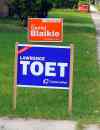When undecided decide in the election
Advertisement
Read this article for free:
or
Already have an account? Log in here »
To continue reading, please subscribe:
Monthly Digital Subscription
$0 for the first 4 weeks*
- Enjoy unlimited reading on winnipegfreepress.com
- Read the E-Edition, our digital replica newspaper
- Access News Break, our award-winning app
- Play interactive puzzles
*No charge for 4 weeks then price increases to the regular rate of $19.00 plus GST every four weeks. Offer available to new and qualified returning subscribers only. Cancel any time.
Monthly Digital Subscription
$4.75/week*
- Enjoy unlimited reading on winnipegfreepress.com
- Read the E-Edition, our digital replica newspaper
- Access News Break, our award-winning app
- Play interactive puzzles
*Billed as $19 plus GST every four weeks. Cancel any time.
To continue reading, please subscribe:
Add Free Press access to your Brandon Sun subscription for only an additional
$1 for the first 4 weeks*
*Your next subscription payment will increase by $1.00 and you will be charged $16.99 plus GST for four weeks. After four weeks, your payment will increase to $23.99 plus GST every four weeks.
Read unlimited articles for free today:
or
Already have an account? Log in here »
Hey there, time traveller!
This article was published 23/09/2015 (3726 days ago), so information in it may no longer be current.
In terms of popular support, polls continue to suggest that the federal election may be headed for a three-way tie. The race couldn’t get more exciting but the data may be deceiving, which is why calling an election so early may be risky business.
It is tempting to predict that the result of this upcoming federal election will be a minority government but unqualified speculations such as these can sometimes end up landing pollsters in hot water. They may even contaminate the democratic process by unduly inundating voters with decision-altering strategic considerations, which they may not have contemplated otherwise.
While it is certainly true that the proportion of Canadians who remain undecided about how they plan to vote on Oct. 19th is uncharacteristically low, this in no way means that voters are already locked in. All it really means is that if the election were held today, we know how most Canadians would likely vote. Don’t forget however that there is still virtually an entire election campaign to go.
By conventional standards, this election campaign is just getting started. So, there is still plenty of time for change, and regardless of what polls suggest about who Canadians claim that they have decided to vote for, as many as seven in 10 might still change their minds.
What we know is that about half to two-thirds of Conservative supporters indicate that they are committed to voting for the Conservatives on voting day. And only 30 to 40 per cent of Liberal and NDP voters say that they are likely to follow through on their voting intentions.
What this suggests is that the results are actually far from even as far as committed voters are concerned. Moreover, the cross-time data from several polls conducted to date suggest that the proportion of committed NDP and Green Party voters has been declining over the duration of the campaign. So there is also the possibility that even so-called “firmly” committed voters may still be open to changing their minds. Furthermore, gauging from the recent Alberta election campaign which also featured large proportions of voters who were openly contemplating change, it is really in the latter stages of the election campaign that the bulk of the action is likely to take place. And this volatility may be more than large enough to have significant game changing effects.
The results of our post-election survey in Alberta, which we administered to over 800 Albertans following their election in May, indicates that only four in 10 voters had decided early on in the campaign about how they were going to vote. The rest told us that they had made up their minds no earlier than two weeks before voting day. About 20 per cent indicated that they only really made up their minds in the last few days before the election and nearly 10 per cent decided on voting day.
So it is possible that when change is on the line, decisions simply take more time to consider and solidify. Or it may even be that voters today are taking more campaign time to decide. Either way, our data also show that people who make decisions in the latter stages of an election campaign are more inclined to take into consideration different decision-making criteria than those who decide early-on.
Besides contemplating between different party leaders, constituency candidates and party platforms, more than half of voters who made their decisions late in the campaign indicated that they did so for strategic reasons. In other words, they voted in part to keep another party from forming government. Often, this meant that they backed a party that is different from the one that they would typically support.
All of this potential for late-stage electoral decision-making suggests that the current federal election contest is likely nowhere near over. In fact, despite what the current polls suggest, it may well be that as voters begin to finalize their electoral choices, that we may still see a significant amount of change.
Poll reports during election campaigns are welcome news because they satisfy our insatiable curiosity about what voters are thinking and how moods may be shifting. But using these data to make early predictions can be akin to basing recommendations on works in progress and it may result in misleading conclusions, fuel further mistrust in the polling industry, and compel voters to make democratic choices that they may not have otherwise made.
Mebs Kanji is an associate professor in political science at Concordia University in Montreal. Kerry Tannahill is a PhD candidate in the department.














